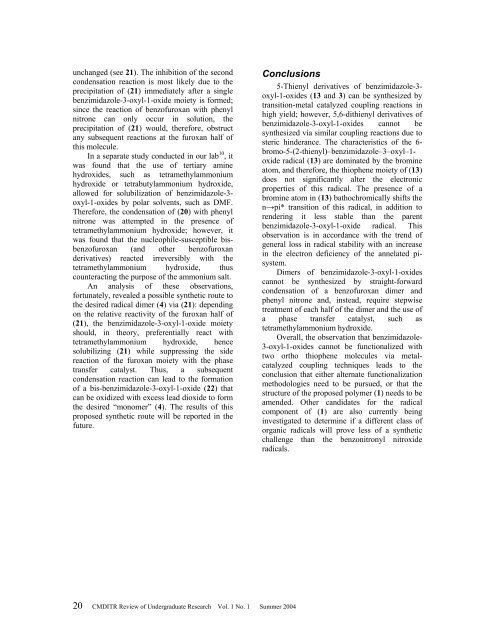CMDITR Review of Undergraduate Research - Pluto - University of ...
CMDITR Review of Undergraduate Research - Pluto - University of ...
CMDITR Review of Undergraduate Research - Pluto - University of ...
Create successful ePaper yourself
Turn your PDF publications into a flip-book with our unique Google optimized e-Paper software.
unchanged (see 21). The inhibition <strong>of</strong> the second<br />
condensation reaction is most likely due to the<br />
precipitation <strong>of</strong> (21) immediately after a single<br />
benzimidazole-3-oxyl-1-oxide moiety is formed;<br />
since the reaction <strong>of</strong> benz<strong>of</strong>uroxan with phenyl<br />
nitrone can only occur in solution, the<br />
precipitation <strong>of</strong> (21) would, therefore, obstruct<br />
any subsequent reactions at the furoxan half <strong>of</strong><br />
this molecule.<br />
In a separate study conducted in our lab 10 , it<br />
was found that the use <strong>of</strong> tertiary amine<br />
hydroxides, such as tetramethylammonium<br />
hydroxide or tetrabutylammonium hydroxide,<br />
allowed for solubilization <strong>of</strong> benzimidazole-3-<br />
oxyl-1-oxides by polar solvents, such as DMF.<br />
Therefore, the condensation <strong>of</strong> (20) with phenyl<br />
nitrone was attempted in the presence <strong>of</strong><br />
tetramethylammonium hydroxide; however, it<br />
was found that the nucleophile-susceptible bisbenz<strong>of</strong>uroxan<br />
(and other benz<strong>of</strong>uroxan<br />
derivatives) reacted irreversibly with the<br />
tetramethylammonium hydroxide, thus<br />
counteracting the purpose <strong>of</strong> the ammonium salt.<br />
An analysis <strong>of</strong> these observations,<br />
fortunately, revealed a possible synthetic route to<br />
the desired radical dimer (4) via (21): depending<br />
on the relative reactivity <strong>of</strong> the furoxan half <strong>of</strong><br />
(21), the benzimidazole-3-oxyl-1-oxide moiety<br />
should, in theory, preferentially react with<br />
tetramethylammonium hydroxide, hence<br />
solubilizing (21) while suppressing the side<br />
reaction <strong>of</strong> the furoxan moiety with the phase<br />
transfer catalyst. Thus, a subsequent<br />
condensation reaction can lead to the formation<br />
<strong>of</strong> a bis-benzimidazole-3-oxyl-1-oxide (22) that<br />
can be oxidized with excess lead dioxide to form<br />
the desired “monomer” (4). The results <strong>of</strong> this<br />
proposed synthetic route will be reported in the<br />
future.<br />
Conclusions<br />
5-Thienyl derivatives <strong>of</strong> benzimidazole-3-<br />
oxyl-1-oxides (13 and 3) can be synthesized by<br />
transition-metal catalyzed coupling reactions in<br />
high yield; however, 5,6-dithienyl derivatives <strong>of</strong><br />
benzimidazole-3-oxyl-1-oxides cannot be<br />
synthesized via similar coupling reactions due to<br />
steric hinderance. The characteristics <strong>of</strong> the 6-<br />
bromo-5-(2-thienyl)–benzimidazole–3–oxyl–1-<br />
oxide radical (13) are dominated by the bromine<br />
atom, and therefore, the thiophene moiety <strong>of</strong> (13)<br />
does not significantly alter the electronic<br />
properties <strong>of</strong> this radical. The presence <strong>of</strong> a<br />
bromine atom in (13) bathochromically shifts the<br />
n→pi* transition <strong>of</strong> this radical, in addition to<br />
rendering it less stable than the parent<br />
benzimidazole-3-oxyl-1-oxide radical. This<br />
observation is in accordance with the trend <strong>of</strong><br />
general loss in radical stability with an increase<br />
in the electron deficiency <strong>of</strong> the annelated pisystem.<br />
Dimers <strong>of</strong> benzimidazole-3-oxyl-1-oxides<br />
cannot be synthesized by straight-forward<br />
condensation <strong>of</strong> a benz<strong>of</strong>uroxan dimer and<br />
phenyl nitrone and, instead, require stepwise<br />
treatment <strong>of</strong> each half <strong>of</strong> the dimer and the use <strong>of</strong><br />
a phase transfer catalyst, such as<br />
tetramethylammonium hydroxide.<br />
Overall, the observation that benzimidazole-<br />
3-oxyl-1-oxides cannot be functionalized with<br />
two ortho thiophene molecules via metalcatalyzed<br />
coupling techniques leads to the<br />
conclusion that either alternate functionalization<br />
methodologies need to be pursued, or that the<br />
structure <strong>of</strong> the proposed polymer (1) needs to be<br />
amended. Other candidates for the radical<br />
component <strong>of</strong> (1) are also currently being<br />
investigated to determine if a different class <strong>of</strong><br />
organic radicals will prove less <strong>of</strong> a synthetic<br />
challenge than the benzonitronyl nitroxide<br />
radicals.<br />
20 <strong>CMDITR</strong> <strong>Review</strong> <strong>of</strong> <strong>Undergraduate</strong> <strong>Research</strong> Vol. 1 No. 1 Summer 2004




